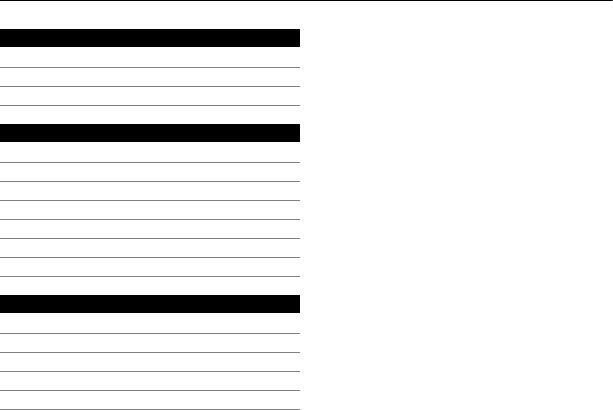Microsoft RM-763 GSM/WCDMA cellular phone w/BT and WLAN User Manual Manual
Microsoft Mobile Oy GSM/WCDMA cellular phone w/BT and WLAN Manual
Manual
Nokia 303 User Guide
Issue 1
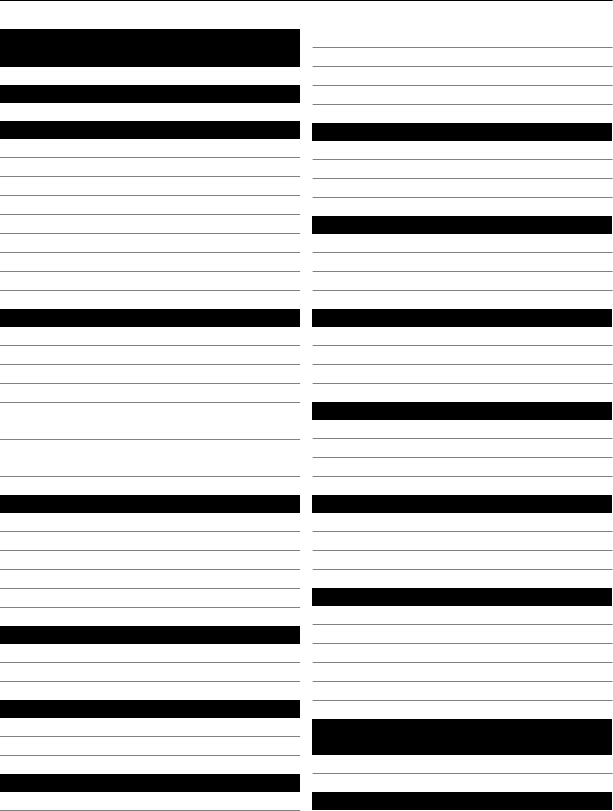
Contents
Safety 4
Get started 5
Keys and parts 5
Write with the keyboard 5
Insert a SIM card and battery 6
Insert a memory card 8
Charge the battery 9
Attach a strap 10
Switch the phone on or off 10
Antenna locations 11
Basic use 11
Access codes 11
Lock the keys and screen 12
Touch screen actions 12
Indicators 14
Copy contacts or pictures from your old
phone 14
Change the volume of a call, song, or
video 15
Calls 15
Make a call 15
Call the last dialled number 15
View your missed calls 15
About internet calls 16
Make an internet call 16
Contacts 17
Save a name and phone number 17
Use speed dial 17
Write text 18
Write using the keyboard 18
Predictive text input 19
Messaging 19
Send a message 19
View a conversation 20
Messaging key 20
Listen to voice messages 20
Send an audio message 21
Personalise your phone 21
About the home screen 21
Personalise the home screen 21
Personalise your phone tones 22
Time management 23
Change the time and date 23
Set an alarm 23
Add an appointment 23
Connectivity 24
Bluetooth 24
USB data cable 25
Connect to a WLAN 26
Music and audio 27
FM radio 27
Media player 29
Media key 30
Pictures and videos 30
Take a picture 30
Record a video 30
Send a picture or video 30
Web 31
About the web browser 31
Browse the web 31
Fit a web page to your phone display 32
Add a bookmark 33
Clear your browsing history 33
Keep in touch with your online
friends 33
About Communities 33
Mail and chat 34
2
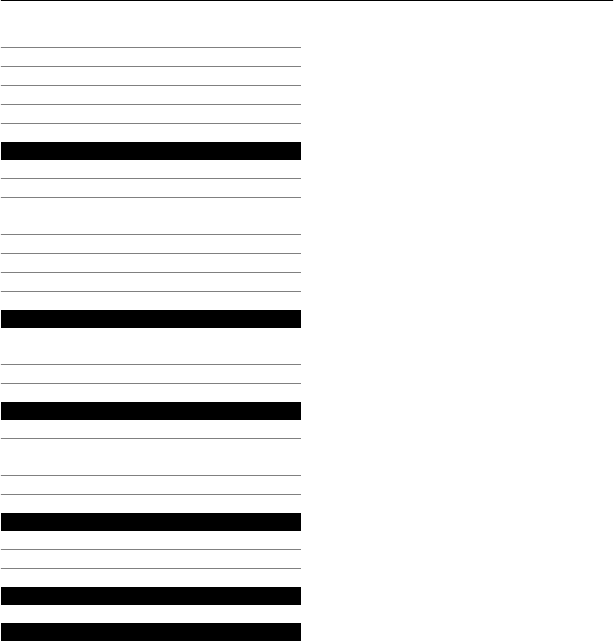
About Mail 34
Send a mail 34
Read and reply to mail 34
About Chat 34
Chat with your friends 35
Nokia Maps 35
About Maps 35
Download maps 35
View your current location on the
map 36
Find a place 36
Share your location or a place 37
Create a walking route 37
Nokia Services 37
Availability and costs of Nokia
Services 37
Access Nokia Services 38
Find help 38
Support 38
Subscribe to the Tips and Offers
service 38
Keep your phone up to date 38
Protect the environment 41
Save energy 41
Recycle 41
Product and safety information 41
Index 48
3

Safety
Read these simple guidelines. Not following them may be dangerous or illegal. For
further information, read the complete user guide.
SWITCH OFF IN RESTRICTED AREAS
Switch the device off when mobile phone use is not allowed or when it may
cause interference or danger, for example, in aircraft, in hospitals or near
medical equipment, fuel, chemicals, or blasting areas. Obey all instructions
in restricted areas.
ROAD SAFETY COMES FIRST
Obey all local laws. Always keep your hands free to operate the vehicle while
driving. Your first consideration while driving should be road safety.
INTERFERENCE
All wireless devices may be susceptible to interference, which could affect
performance.
QUALIFIED SERVICE
Only qualified personnel may install or repair this product.
KEEP YOUR DEVICE DRY
Your device is not water-resistant. Keep it dry.
PROTECT YOUR HEARING
Listen to a headset at a moderate level, and do not hold the device near your
ear when the loudspeaker is in use.
4
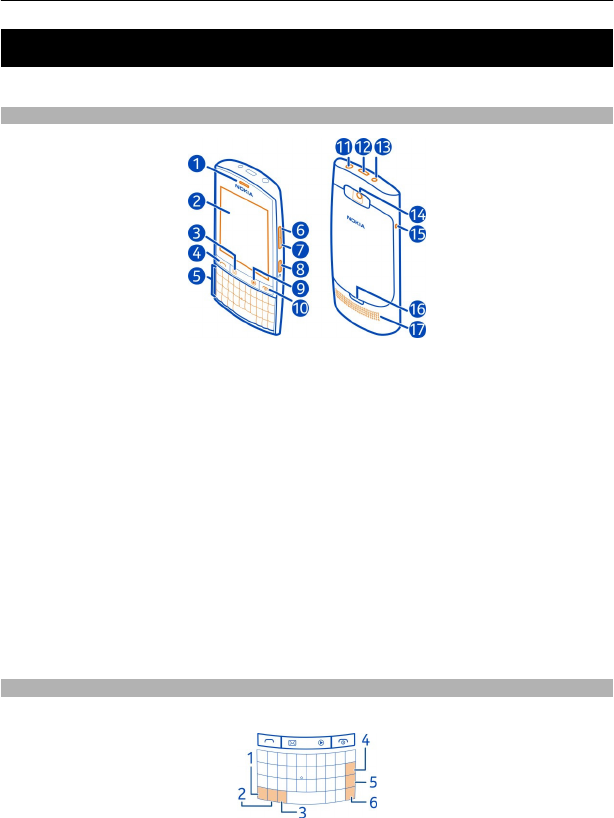
Get started
Learn how to start using your phone.
Keys and parts
1Earpiece
2Touch screen
3Messaging key
4Call key
5Keyboard
6Volume up/Zoom in key
7Volume down/Zoom out key
8Key lock button
9Media key
10 End/Power key
11 Nokia AV connector (3.5 mm)
12 Micro-USB connector
13 Charger connector
14 Camera lens. Before using the camera, remove the protective tape from the lens.
15 Wrist strap hole
16 Back cover release latch
17 Loudspeaker
Write with the keyboard
Your phone has a full keyboard.
5

1 Function key. To insert special characters printed at the top of keys, press the
function key, and then press the corresponding key. To enter several special
characters in a row, press the function key twice. To return to normal mode, press
the function key.
2 Shift key. To switch between the upper and lower case modes, press the shift key
twice. To enter a single upper case letter in lower case mode, or a single lower case
letter in upper case mode, press the shift key, and then press the desired alphabet
key.
3 Sym key. To insert special characters not shown on the keyboard, press the sym
key, and select the desired character.
4 Backspace key. To delete a character, press the backspace key. To delete several
characters, press and hold the backspace key.
5 Enter key. To move the cursor to the next row or text input field, press the enter
key. Additional functions are based on the current context. For example, in the web
address field of the web browser, the enter key acts as the Go icon.
6 Ctrl key
Insert a variation of a letter
You can insert, for example, letters with accents. To insert á, press and hold the sym
key, and then press A repeatedly, until the desired letter is displayed. The order and
availability of letters depends on the selected writing language.
Insert a SIM card and battery
Note: Switch the device off and disconnect the charger and any other device before
removing any covers. Avoid touching electronic components while changing any covers.
Always store and use the device with any covers attached.
Important: Do not use a mini-UICC SIM card, also known as a micro-SIM card, a micro-
SIM card with an adapter, or a SIM card that has a mini-UICC cutout (see figure) in this
device. A micro SIM card is smaller than the standard SIM card. This device does not
support the use of micro-SIM cards and use of incompatible SIM cards may damage the
card or the device, and may corrupt data stored on the card.
This phone is intended for use with a BP-3L battery. Always use original Nokia batteries.
The SIM card and its contacts can be easily damaged by scratches or bending, so be
careful when handling, inserting, or removing the card.
1 Switch the phone off.
6

2 Pull the back cover release latch towards the bottom of the phone, and remove the
cover.
3 Remove the battery, if inserted.
4 Lift the SIM card holder cover, make sure the contact area of the SIM card is facing
down, and place the card in the holder.
7
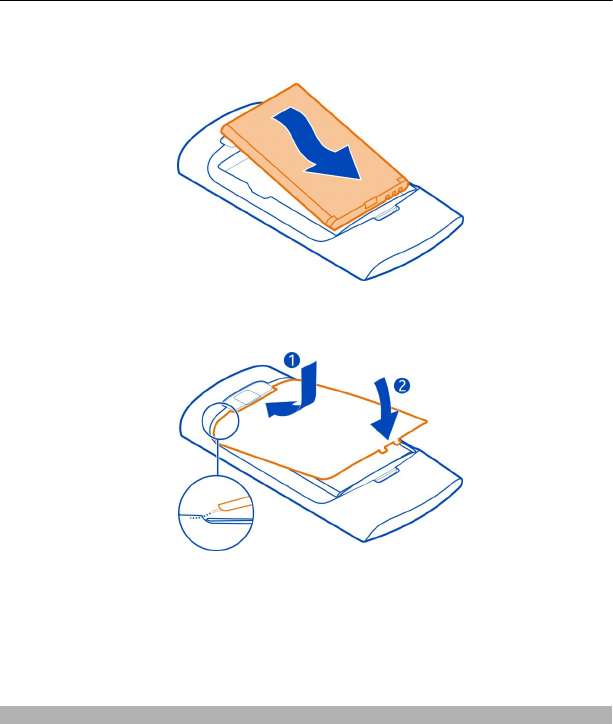
5 Lower the SIM card holder cover.
6 Line up the battery contacts, and insert the battery.
7 Direct the top locking catches toward their slots, and press down until the cover
locks into place.
Remove the SIM card
1 Switch the phone off.
2 Remove the back cover.
3 Remove the battery, if inserted.
4 Lift the SIM card holder cover, and remove the SIM card.
Insert a memory card
Use only compatible memory cards approved by Nokia for use with this device.
Incompatible cards may damage the card and the device and corrupt data stored on the
card.
Your phone supports memory cards with a capacity of up to 32 GB.
8
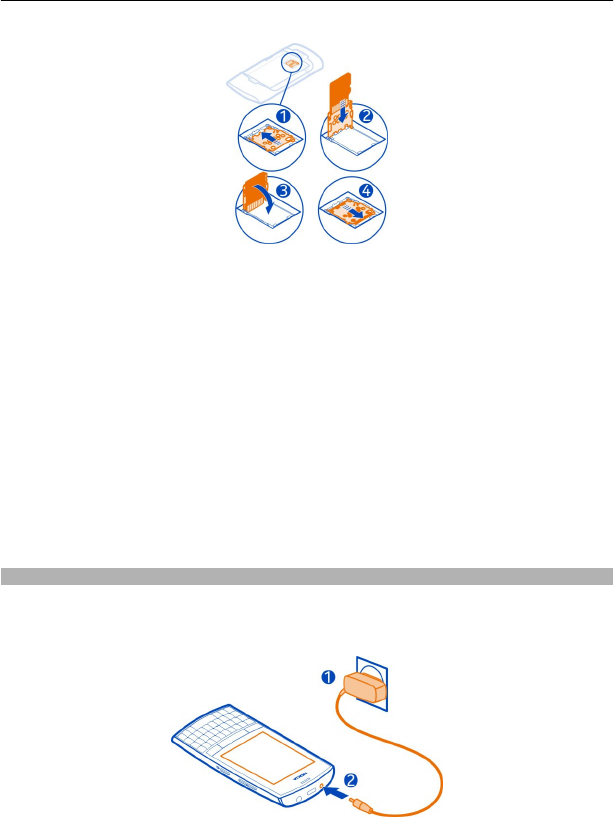
1 Switch the phone off, and remove the back cover and battery.
2 To release the memory card holder, slide the holder in the direction indicated by
the arrow on the holder. Lift the memory card holder (1).
3 Make sure the contact area of the memory card would face down, and insert the
card (2).
4 Lower the memory card holder (3).
5 To lock the memory card holder, slide the holder to its original position (4).
Remove the memory card
1 Switch the phone off.
2 Remove the back cover and battery.
3 To release the memory card holder, slide the holder in the direction indicated by
the arrow on the holder. Open the memory card holder, and remove the memory
card.
Charge the battery
Your battery has been partially charged at the factory, but you may need to recharge it
before you can switch on your phone for the first time. If the phone indicates a low
charge, do the following:
9
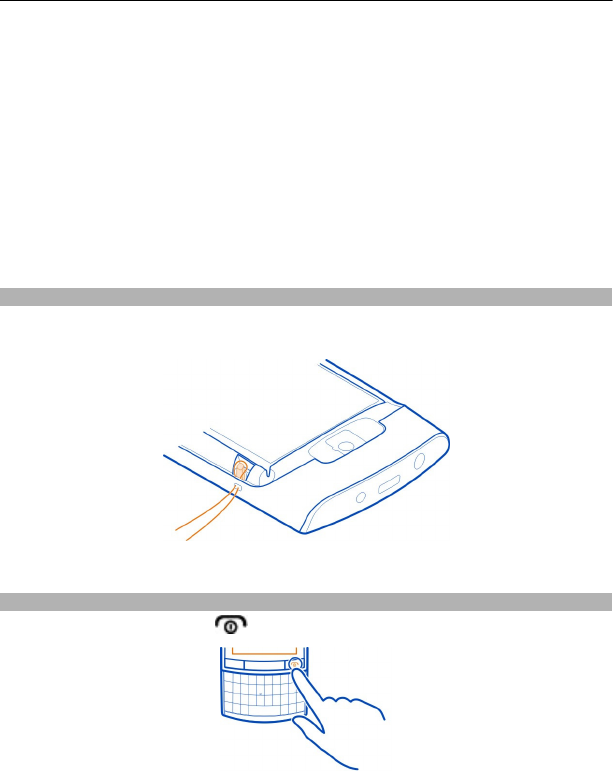
1 Connect the charger to a wall outlet.
2 Connect the charger to the phone.
3 When the phone indicates a full charge, disconnect the charger from the phone,
then from the wall outlet.
You do not need to charge the battery for a specific length of time, and you can use the
phone while it is charging.
If the battery is completely discharged, it may take several minutes before the charging
indicator is displayed or before any calls can be made.
If the battery has not been used for a long time, to begin charging, you may need to
connect the charger, then disconnect and reconnect it.
Attach a strap
Remove the back cover, thread the strap through the hole, and loop the strap around
the wrist strap peg.
The strap may be available separately.
Switch the phone on or off
Press and hold the power key until the phone vibrates.
10
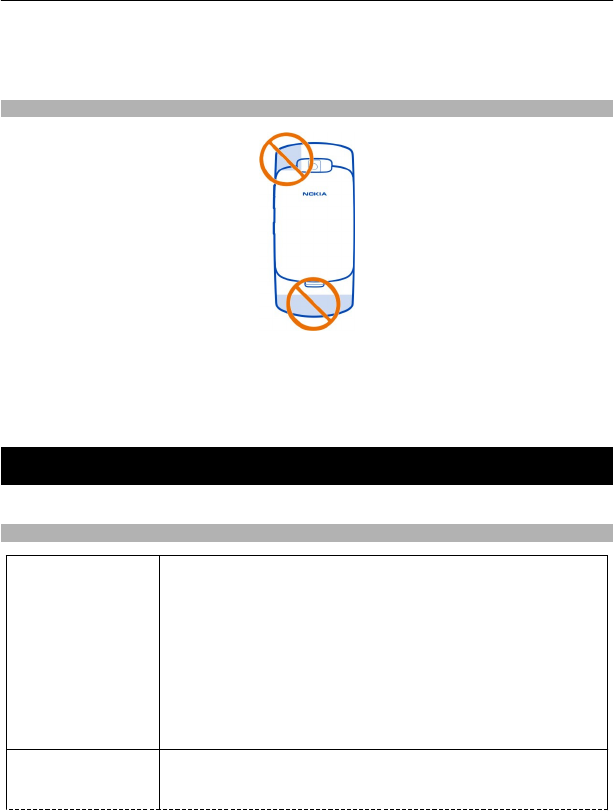
You may be prompted to get the configuration settings from your network service
provider. For more information on this network service, contact your network service
provider.
Antenna locations
The antenna area is highlighted.
Avoid touching the antenna area while the antenna is in use. Contact with antennas
affects the communication quality and may reduce battery life due to higher power level
during operation.
Basic use
Learn how to use the basic features of your phone.
Access codes
PIN or PIN2 code
(4-8 digits)
These protect your SIM card against unauthorised use or are
required to access some features.
You can set your phone to ask for the PIN code when you switch
it on.
If not supplied with your SIM card or you forget the codes,
contact your service provider.
If you enter the code incorrectly three times in a row, you need
to unblock the code with the PUK or PUK2 code.
PUK or PUK2 code
(8 digits)
These are required to unblock a PIN or PIN2 code.
If not supplied with your SIM card, contact your service provider.
11
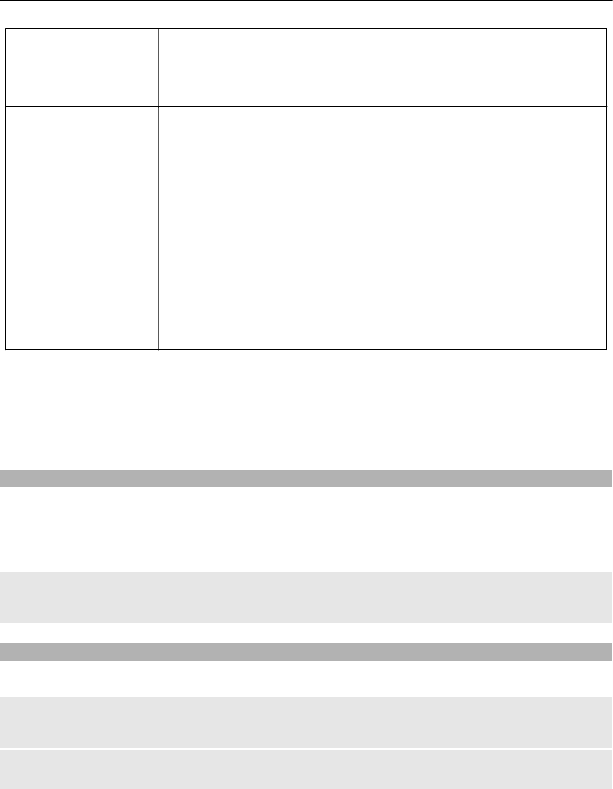
IMEI number
(15 digits)
This is used to identify valid phones in the network. The number
can also be used to block, for example, stolen phones.
To view your IMEI number, dial *#06#.
Lock code (security
code)
(min. 5 digits)
This helps you protect your phone against unauthorised use.
You can set your phone to ask for the lock code that you define.
The default lock code is 12345.
Keep the code secret and in a safe place, separate from your
phone.
If you forget the code and your phone is locked, your phone will
require service. Additional charges may apply, and all the
personal data in your phone may be deleted.
For more information, contact a Nokia Care Point or your phone
dealer.
The personal unblocking key (PUK) code and the universal personal unblocking key
(UPUK) code (8 digits) are required to change a blocked PIN code and UPIN code,
respectively. The PUK2 code (8 digits) is required to change a blocked PIN2 code. These
codes are not supplied with the SIM card. Contact your local service provider for the
codes.
Lock the keys and screen
To avoid accidentally making a call when your phone is in your pocket or bag, lock the
keys and screen of your phone.
Press the key lock button.
Unlock the keys and screen
Press the key lock button, and select Unlock.
Touch screen actions
To interact with the touch screen user interface, tap or tap and hold the touch screen.
Open an application or other screen element
Tap the application or element.
Access item-specific options
Tap and hold the item. A pop-up menu with available options opens.
12
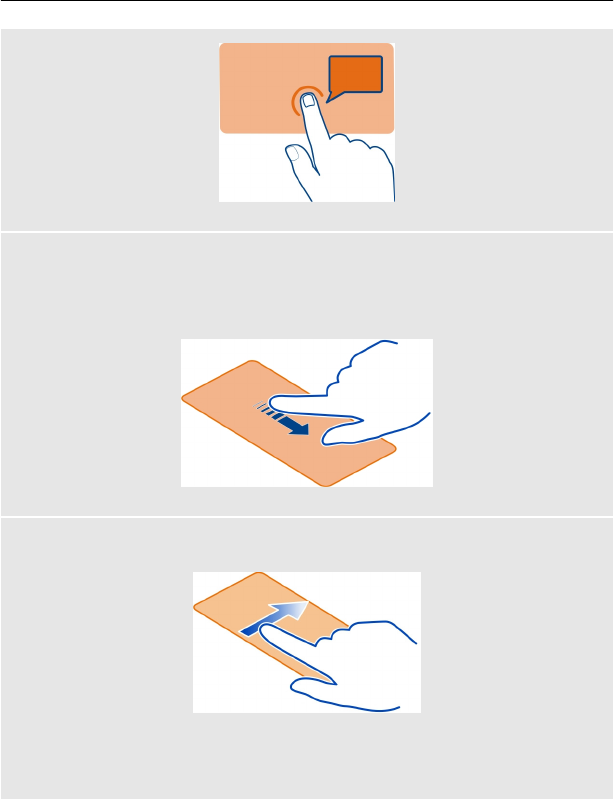
Scroll in a list or menu
Place your finger on the screen, slide it quickly up or down the screen, and then lift your
finger. The content of the screen scrolls with the speed and direction it had at the
moment of release. To select an item from a scrolling list and to stop the movement,
tap the item.
Swipe
Place a finger on the screen, and steadily slide your finger in the desired direction.
For example, when you are viewing a picture, to view the next picture, swipe left. To
quickly browse through your pictures, swipe the screen quickly, and then scroll left or
right through the thumbnails.
13

Indicators
You have unread messages.
You have unsent, cancelled, or failed messages.
The keypad is locked.
The phone does not ring for incoming calls or text messages.
An alarm is set.
or The phone is registered to the GPRS or EGPRS network.
or A GPRS or EGPRS connection is open.
or The GPRS or EGPRS connection is suspended (on hold).
The phone is registered to a 3G (UMTS) network.
or The phone is registered to a 3.5G (HSDPA) network.
Bluetooth is activated.
WLAN is activated.
If you have two phone lines, the second line is in use.
All incoming calls are diverted to another number.
Calls are limited to a closed user group.
The currently active profile is timed.
A headset is connected to the phone.
The phone is connected to another device, using a USB data cable.
Copy contacts or pictures from your old phone
Want to copy your content from your previous compatible Nokia phone and start using
your new phone quickly? You can copy, for example, contacts, calendar entries, and
pictures to your new phone, free of charge.
1 Activate Bluetooth in both phones.
Select Menu > Settings > Connectivity > Bluetooth and On.
2 Select Menu > Settings > Sync & backup.
3 Select Phone switch > Copy to this.
14

4 Select the content to copy and Done.
5 Select your previous phone from the list.
6 If the other phone requires a passcode, enter the passcode. The passcode, which
you can define yourself, must be entered in both phones. The passcode in some
phones is fixed. For details, see the user guide of the other phone.
The passcode is valid only for the current connection.
7 If prompted, allow connection and copying requests.
Change the volume of a call, song, or video
Use the volume keys.
The built-in loudspeaker allows you to speak and listen from a short distance without
having to hold the phone to your ear.
Activate the loudspeaker during a call
Select Loudsp..
Calls
Learn how to make and receive calls.
Make a call
1 On the home screen, enter the phone number.
To delete a number, select Clear.
To enter the + character, used for international calls, press +. The + character may
not work in all regions. In this case, enter the international access code directly.
2 To make the call, press the call key.
3 To end the call, press the end key.
Tip: To use the virtual keypad to enter the phone number, press the call key, and select
Dialler.
Call the last dialled number
Trying to call someone, but they are not answering? It is easy to call them again.
1 On the home screen, press the call key.
2 Go to the number, and press the call key.
View your missed calls
Want to see who made the call you missed?
15

On the home screen, select View. The caller's name is displayed, if stored in the contacts
list.
Missed and received calls are logged only if supported by the network, and the phone
is switched on and within the network service area.
Call back the contact or number
Go to the contact or number, and press the call key.
View the missed calls later
Select Menu > Contacts > Log and Missed calls.
About internet calls
You can make and receive calls over the internet (network service). Internet call services
may support calls between computers, between mobile phones, and between a Voice
over Internet Protocol (VoIP) device and a traditional telephone.
Some internet call service providers allow free internet calls. For availability and
connectivity costs, contact your internet call service provider.
The use of VoIP or other services may be restricted in some countries. For more
information, contact your phone retailer, service provider, or local authorities.
To make or receive an internet call, you must be in the service area of a WLAN or 3G
network, and be signed in to an internet call service.
When using the 3G network for making internet calls, check that your service provider
supports internet calls in the 3G network. Flat-rate data plans are recommended to save
costs.
Tip: If you do not have a flat-rate data plan from your service provider, to save data
costs in your phone bill when making internet calls, use a WLAN.
Make an internet call
When you are signed into an internet call service, you can make internet calls.
The Net phone wizard helps you set up your account. Have your account information
from your internet call service provider available before you start the wizard.
Set up your internet telephone account
1 Make sure a valid SIM card is inserted, and that your phone is connected to a WLAN
or 3G network.
2 Select Menu > Settings and Connectivity > Internet telephone > Accounts.
3 Select Add new.
16

4 Select an account and Connect, and follow the displayed instructions.
When the wizard has finished, your account is displayed in the accounts list.
If the internet telephone settings do not work, contact your service provider.
Call a contact
1 Select Menu > Contacts and Names.
2 Select the contact and Internet call.
Call a phone number
Enter the phone number, and select Options > Internet call.
For emergency calls, only the cellular network is used.
Contacts
Learn how to save names, phone numbers, and mail addresses to your phone.
Save a name and phone number
Select Menu > Contacts.
Select Add new, and enter the number and name.
Add or edit the details of a contact
1 Select Names and a contact.
2 Select Options > Add detail.
Tip: To add a ringtone or picture for a contact, select the contact and Options > Add
detail > Multimedia.
Use speed dial
You can quickly call your friends and family when you assign your most-used phone
numbers to the number keys of your phone.
Select Menu > Contacts > Speed dials.
Assign a phone number to a number key
1 Select a number key. 1 is reserved for the voice mailbox.
2 Enter a number or search for a contact.
Remove or change a phone number assigned to a number key
Select and hold the number key, and from the pop-up menu, select Delete or Change.
17
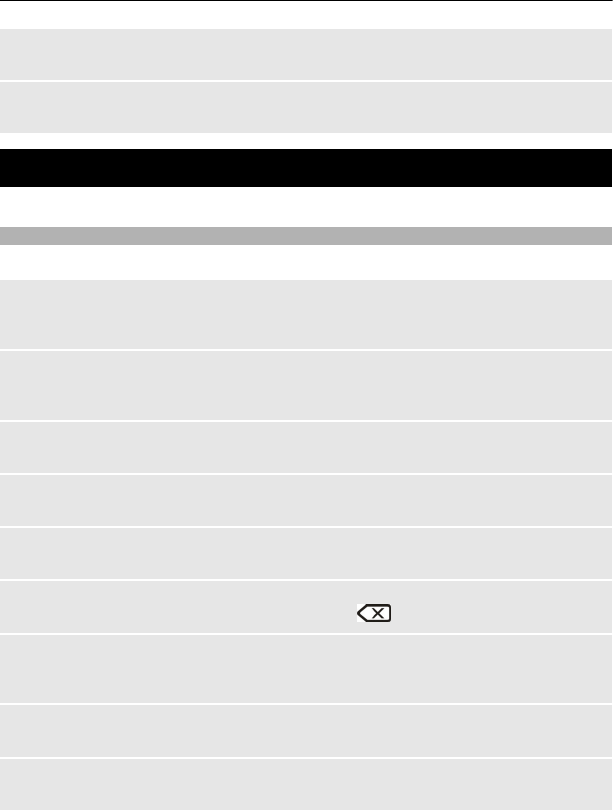
Make a call
On the home screen, press and hold a number key.
Deactivate speed dialling
Select Menu > Settings and Call > Speed dialling > Off.
Write text
The input methods provided in the phone may vary according to different sales markets.
Write using the keyboard
Your phone has a full keyboard.
Set the writing language
Select Options > Writing language and the desired language. To change the writing
language, you can also press the function key, and then press the ctrl key.
Switch between number and letter mode
Press the function key repeatedly, until the symbol for the desired input method is
displayed.
Lock number mode
Press the function key twice. To return to normal mode, press the function key.
Switch between the character cases
Press the shift key.
Insert a number or character printed at the top right corner of a key
Press and hold the corresponding key.
Delete a character
Select Clear. You can also press the backspace key .
Insert a special character or symbol
Press the sym key, and select the desired symbol. To view more symbols, press the sym
key again.
Insert a new line
Press the enter key.
Insert a space
Press the space key.
18
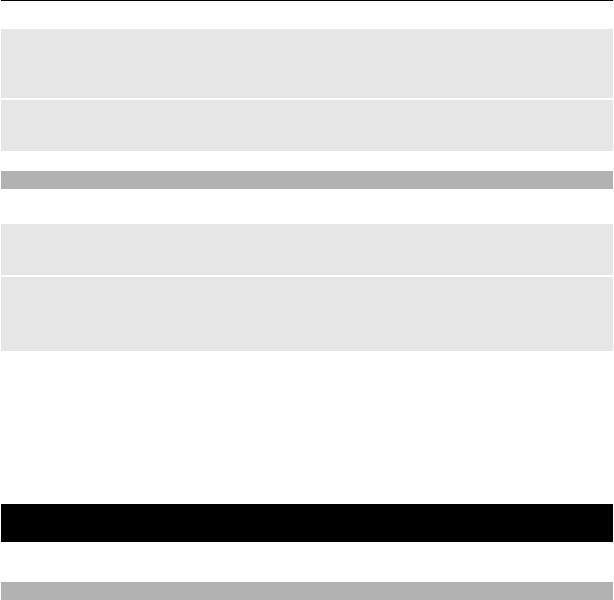
Copy or cut text
Press and hold the shift key, and scroll to highlight a word, phrase, or section of text.
Press and hold the ctrl key, and then press C (copy) or X (cut).
Paste text
Go to the desired location, press and hold the ctrl key, and then press V.
Predictive text input
Predictive text input is based on a built-in dictionary. Not all languages are supported.
Activate or deactivate predictive text input
Select Options > Prediction sett. > On or Off.
Switch between predictive and traditional text input
Press and hold the ctrl key, and then press the space key.
You can also select and hold Options.
Write text with predictive text input
1 Start writing a word, using the character keys. Your phone suggests possible words.
2 To confirm a word, press the space key.
If the word is not correct, scroll through the list of suggested words, and select the
desired word.
3 Start writing the next word.
Messaging
Learn how to send and receive text, multimedia, and audio messages.
Send a message
Keep in touch with your family and friends with text and multimedia messages. You can
attach your pictures, videos, and business cards to your message.
Select Menu > Messaging.
1 Select Create message.
2 To add an attachment , select Options > Insert object.
3 Write your message, and select Continue.
4 To enter a phone number or mail address manually, select Number or mail. Enter
a phone number, or select Mail, and enter a mail address.
5 Select Send.
19
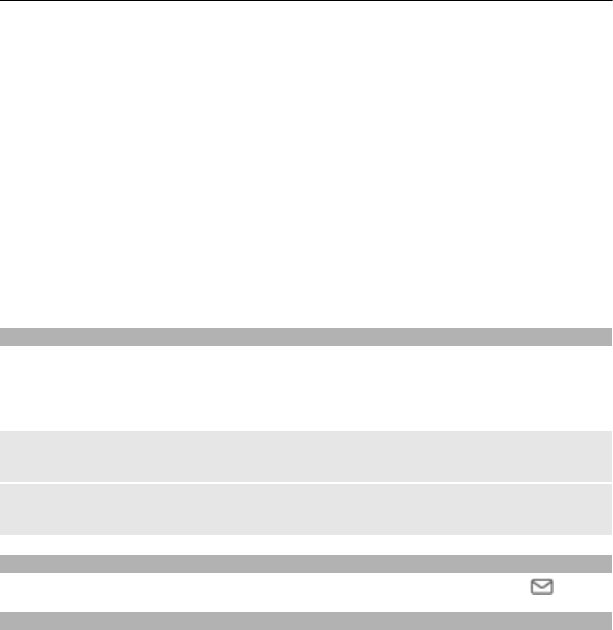
Tip: To insert a special character or smiley, select Options > Insert symbol.
Sending a message with an attachment may be more expensive than sending a normal
text message. For more information, contact your service provider.
You can send text messages that are longer than the character limit for a single message.
Longer messages are sent as two or more messages. Your service provider may charge
accordingly.
Characters with accents, other marks, or some language options, take more space,
limiting the number of characters that can be sent in a single message.
If the item you insert in a multimedia message is too large for the network, the device
may automatically reduce the size.
Only compatible devices can receive and display multimedia messages. Messages may
look different in different devices.
View a conversation
You can see the messages you have sent to and received from a particular contact from
a single view, and continue the conversation from that view.
Select Menu > Messaging.
Read a message in a conversation
Select Conversations, a conversation, and a message.
Switch to the traditional Inbox view
Select Options > Inbox view.
Messaging key
To write a message or check your message inbox, press the messaging key .
Listen to voice messages
When you can't answer, you can divert calls to your voice mailbox and listen to your
messages later.
You may need a voice mailbox subscription. For more information on this network
service, contact your service provider.
1 Select Menu > Messaging > Voice messages > Voice call messages and Voice
mailbox no..
2 Enter your voice mailbox number, and select OK.
3 To call your voice mailbox, on the home screen, press and hold 1.
20
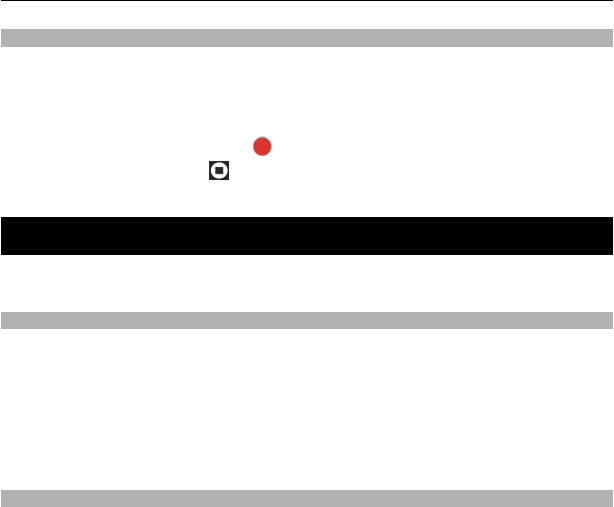
Send an audio message
Don't have time to write a text message? Record and send an audio message instead.
Select Menu > Messaging.
1 Select Other messages > Audio message.
2 To record your message, select .
3 To stop recording, select .
4 Select Continue and a contact.
Personalise your phone
Learn how to personalise the home screen and main menu, and how to change
ringtones.
About the home screen
On the home screen, you can:
•See notifications of missed calls and received messages
•Open your favourite applications
•Add shortcuts for different features, such as taking a picture or browsing the web
•View your favourite contacts, and quickly call, text, or send mail to them
•Access your favourite social networking services
Personalise the home screen
Want to see your favourite landscape or pictures of your family in the background of
the home screen? You can change this wallpaper, and rearrange items on the home
screen, to personalise it to your liking.
Change the wallpaper
1 Select Menu > Settings and Display > Wallpaper.
2 Select a folder and a picture.
You can also take a picture with your phone camera, and use that picture.
Tip: Download more wallpapers from Nokia Store. For more information, go to
www.nokia.com/support.
Add an application or shortcut
1 Tap and hold the home screen, and from the pop-up menu, select Personalise
view.
2 Select the bar, an item from the list, and Done.
21
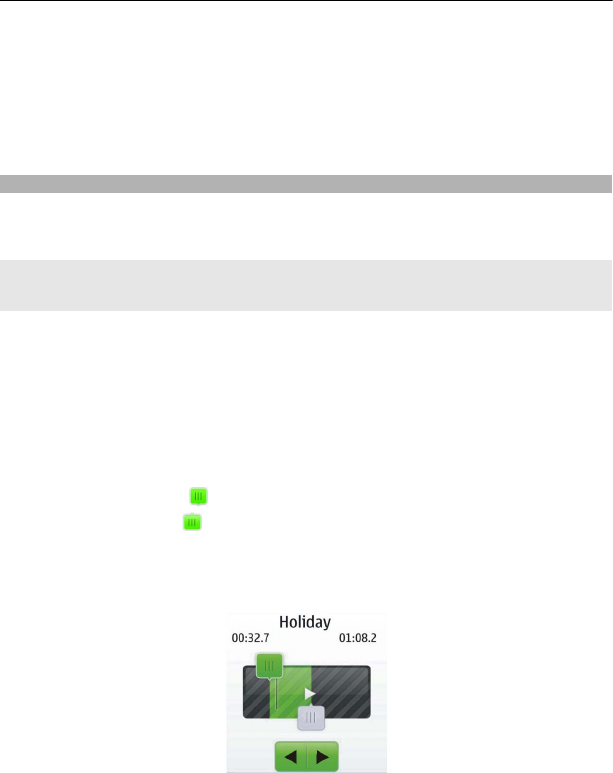
Change a shortcut
1 Tap and hold the shortcut you want to change, and from the pop-up menu, select
Change shortcut.
2 Select an item from the list.
Tip: To increase the font size in the Messaging and Contacts applications, or in the main
menu, select Menu > Settings and Display > Font size.
Personalise your phone tones
You can personalise the ringtones and key and warning tones for each profile.
Select Menu > Settings and Tones.
Change the ringtone
Select Ringtone: and a ringtone.
Tip: Download more ringtones from Nokia Store. To learn more about Nokia Store, go
to www.nokia.com/support.
After selecting a ringtone, you can mark a section of the ringtone, and set the section
as your ringtone. The original ringtone or sound clip is not copied or modified. Preset
ringtones cannot be modified, and not all formats of ringtones are supported.
Mark the section to use
1 Select a ringtone. When prompted, select Yes.
2 Drag the start marker to the start point.
3 Drag the end marker to the end point.
When a marker is moved to a new point, the selection plays.
4 To manually play the selection, select Play.
5 Select Done.
22

Tip: To fine-tune the start and end points of the selection, select or , and select
and hold or .
Change the volume of the keypad tones
Select Keypad tones:, and drag the volume bar.
Time management
Learn how to use your phone clock and calendar.
Change the time and date
Select Menu > Settings and Date and time.
Change the time zone when travelling
1 Select Date & time settings > Time zone:.
2 Select the time zone of your location.
3 Select Save.
The time and date are set according to the time zone. This makes sure that your phone
displays the correct sending time of received text or multimedia messages.
For example, GMT -5 denotes the time zone for New York (USA), 5 hours west of
Greenwich, London (UK).
Set an alarm
You can use your phone as an alarm clock.
On the home screen, select the clock.
1 Set the alarm time.
2 Select to set the alarm.
3 To set the alarm to sound, for example, at the same time every day, select
Settings > Alarm repeat > On and the days.
Tip: To open the alarm clock, you can also select Menu > Apps > Alarm clock.
Add an appointment
Save your important appointments to your calendar as meeting entries.
Select Menu > Calendar.
1 Go to the desired date, and select Options > Add new entry.
2 Select Meeting, and fill in the fields.
23
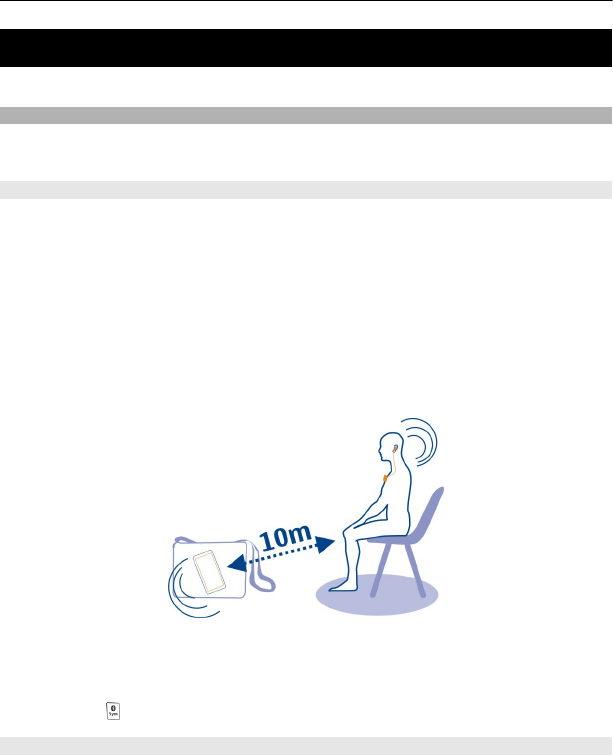
Connectivity
Learn how to connect your phone to other phones or devices, to send and receive data.
Bluetooth
Learn how to connect wirelessly to other compatible phones or devices, to send and
receive content, such as music or pictures.
About Bluetooth connectivity
Select Menu > Settings > Connectivity > Bluetooth.
You can connect wirelessly to other compatible devices, such as phones, computers,
headsets, and car kits.
You can use the connection to send items from your phone, copy files from your
compatible PC, and print files with a compatible printer.
Since devices with Bluetooth wireless technology communicate using radio waves, they
do not need to be in direct line-of-sight. However, they must be within 10 metres (33
feet) of each other, although the connection may be subject to interference from
obstructions such as walls or from other electronic devices.
When your phone is locked, it is only possible to connect to a paired device that has
been set to Auto-connect.
Tip: To quickly access the Bluetooth settings, on the home screen, press and hold the
Bluetooth key .
Send a picture or other content to another device using Bluetooth
Use Bluetooth to send pictures, videos, business cards, and other content created by
you to your computer or a friend's compatible phone or device.
24

1 Select and hold the item to send, and from the pop-up menu, select Send > Via
Bluetooth.
2 Select the device to connect to. If the desired device is not displayed, to search for
it, select Options > New search. Bluetooth devices within range are displayed.
3 If the other device requires a passcode, enter the passcode. The passcode, which
you can define yourself, must be entered in both devices. The passcode in some
devices is fixed. For details, see the user guide of the device.
The passcode is valid only for the current connection.
The available options may vary.
USB data cable
Learn how to use a USB data cable to copy music or pictures to and from your phone.
Copy content between your phone and a computer
You can use a USB data cable to copy your pictures and other content between your
phone and a compatible computer.
1 Use a USB data cable to connect your phone to a computer.
2 Select from the following modes:
Nokia Suite — Nokia Suite is installed on your computer.
Media transfer — Nokia Suite is not installed on your computer. If you want to
connect your phone to a home entertainment system or printer, use this mode.
Mass storage — Nokia Suite is not installed on your computer. The phone is
displayed as a portable device on your computer. Make sure a memory card is
inserted. If you want to connect your phone to other devices, such as a home or car
stereo, use this mode.
3 To copy the content, use the file manager of the computer.
To copy your contacts, music files, videos, or pictures, use Nokia Suite.
Copy a picture or other content between your phone and a USB memory stick
You can copy pictures from your phone to a compatible USB memory stick. Use this to
create backups of pictures that you take when travelling.
1 Connect a compatible USB OTG adapter cable to the micro-USB connector of your
phone.
2 Connect a memory stick to the USB OTG adapter cable.
25
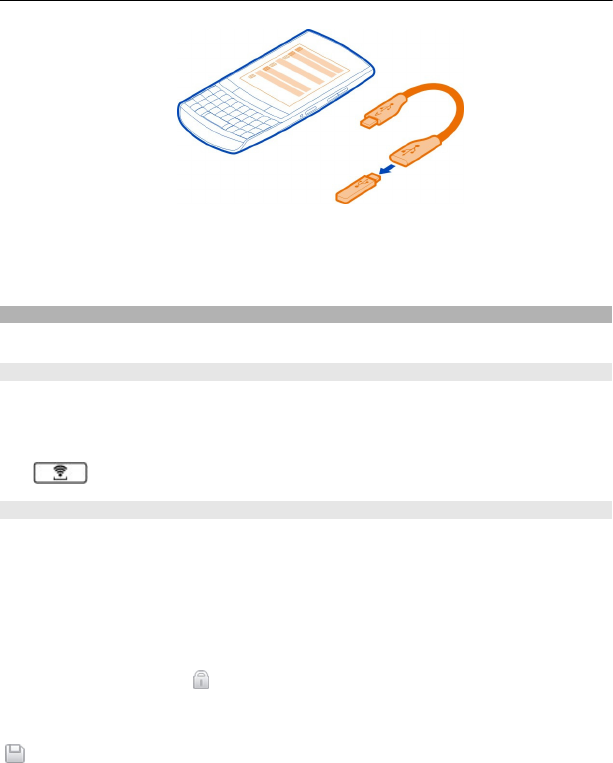
3 Select Menu > Apps > Gallery, and select and hold a file or folder.
4 Select if you want to copy or move the file or folder.
5 Select the target folder.
Connect to a WLAN
Learn how to connect to the internet using a WLAN connection.
About WLAN connections
Select Menu > Settings > Connectivity > WLAN.
Connect to a wireless local area network (WLAN) and manage your WLAN connections.
Tip: To quickly access the WLAN settings, on the home screen, press and hold the WLAN
key .
Connect to a WLAN at home
To help save data costs, connect to your home WLAN when you are at home and want
to browse the web on your phone.
Select Menu > Settings > Connectivity > WLAN.
Connect for the first time
1 To search for your home WLAN, select Available WLANs.
2 To connect, select your home WLAN.
3 If the WLAN is secured , enter the password.
4 If you save your home WLAN, you do not always have to search for it in future. Select
and hold the WLAN, and from the pop-up menu, select Save.
indicates a saved WLAN.
Connect to your saved home WLAN
1 Select Saved WLANs.
26

2 Select and hold your home WLAN, and from the pop-up menu, select Connect.
Disconnect from a WLAN
Select and hold the connected WLAN , and from the pop-up menu, select
Disconnect.
Connect to a WLAN on the move
Connecting to a WLAN is a handy way of accessing the internet when not at home.
Connect to public WLANs in public places, such as a library or internet café.
Select Menu > Settings > Connectivity > WLAN.
You need a password to connect to secured WLANs .
1 To search for available WLANs, select Available WLANs.
2 Select a WLAN.
3 If the WLAN is secured, enter the password.
Disconnect from a WLAN
Select the connected WLAN .
Connect to a hidden WLAN
Select Menu > Settings > Connectivity > WLAN.
You can connect to a hidden WLAN, if you know the name (SSID) and password.
1 To search for available WLANs, select Available WLANs.
2 Select (Hidden network).
3 Enter the name (SSID) and the password.
Disconnect from a WLAN
Select the connected WLAN .
Music and audio
Learn how to listen to music from your phone or FM radio.
FM radio
Learn how to listen to FM radio stations on your phone.
27
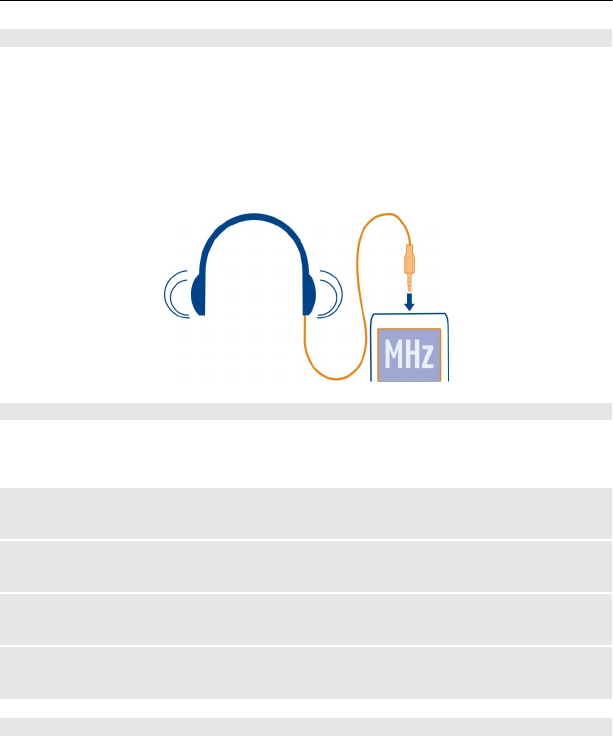
About the FM radio
Select Menu > Music > Radio.
You can listen to FM radio stations using your phone - just connect a headset, and select
a station.
To listen to the radio, you need to connect a compatible headset to the device. The
headset acts as an antenna.
It is not possible to listen to the radio through a Bluetooth headset.
Listen to the radio
Connect a compatible headset to your phone. The headset acts as an antenna.
Select Menu > Music > Radio.
Change the volume
Use the volume keys.
Close the radio
Press the end key.
Set the radio to play in the background
Select Options > Play in backgr..
Close the radio when it is playing in the background
Press and hold the end key.
Find and save radio stations
Search for your favourite radio stations, and save them, so you can easily listen to them
later.
Select Menu > Music > Radio.
28

Search for the next available station
Select and hold or .
Save a station
Select Options > Save station.
Automatically search for radio stations
Select Options > Search all stat.. For best results, search when outdoors or near a
window.
Switch to a saved station
Select or .
Rename a station
1 Select Options > Stations.
2 Select and hold the station, and from the pop-up menu, select Rename.
Automatically switch to a frequency with better reception
1 Select Options > Settings > RDS > On.
2 Select Options > Settings > Auto-frequency > On.
Tip: To access a station directly from the saved station list, press the number key that
corresponds to the number of the station.
Media player
Learn how to play music and videos on your phone.
Play a song
Play music stored in the phone memory or on the memory card.
Select Menu > Music > My music and All songs.
1 Select a song.
2 To pause playing, select ; to resume, select .
Play a video
Play videos stored in the phone memory or on the memory card.
Select Menu > Photos > My videos.
1 Select a video.
2 To pause playback, select ; to resume, select .
29
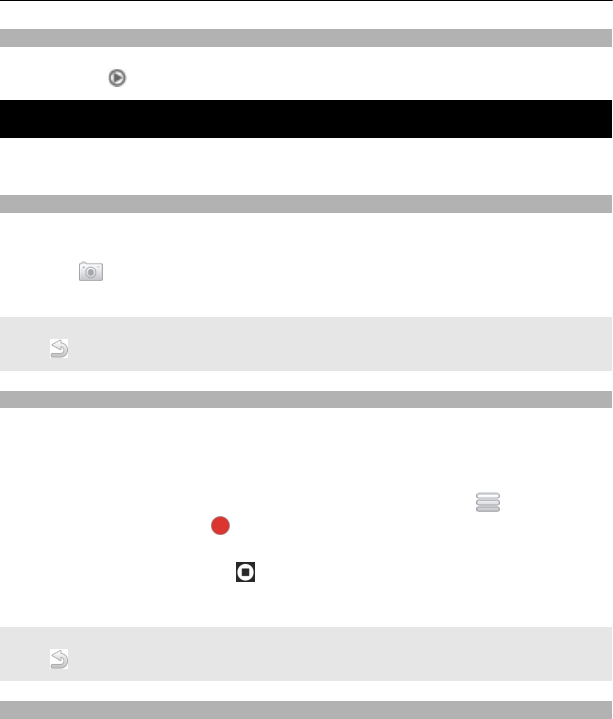
Media key
To open either the media player or the radio, depending on which was last used, press
the media key .
Pictures and videos
Learn how to take pictures or record videos with your phone, and how to share them
with your friends and family.
Take a picture
1 Select Menu > Photos > Camera.
2 To zoom in or out, use the volume keys.
3 Select .
The pictures are saved in Menu > Photos > My photos.
Close the camera
Select .
Record a video
Besides taking pictures with your phone, you can also capture your special moments as
videos.
Select Menu > Photos > Video camera.
1 To switch from image mode to video mode, if necessary, select > Video c..
2 To start recording, select .
To zoom in or out, use the volume keys.
3 To stop the recording, select .
Videos are saved in Gallery.
Close the camera
Select .
Send a picture or video
Want to share your pictures and videos with friends and family? Send a multimedia
message or send a picture using Bluetooth.
Select Menu > Photos.
1 Select the folder containing the picture or video.
30

2 Select and hold the picture or video, and from the pop-up menu, select Send and
the sending method.
Send several pictures at the same time
1 Select the folder containing the pictures.
2 Select > Mark, and mark the pictures.
3 Select > Send marked and the sending method.
Send several videos at the same time
1 Select the folder containing the videos.
2 Select Options > Mark, and mark the videos.
3 Select Options > Send marked and the sending method.
Web
Learn how to browse the web on your phone.
About the web browser
Select Menu > Internet.
Catch up on the news, and visit your favourite websites. You can use the web browser
to view web pages on the internet.
The web browser compresses and optimises web content for your phone, so you can
browse the web more quickly and save on data costs.
To browse the web, you must be connected to the internet.
For availability, pricing, and instructions, contact your service provider.
You may receive the configuration settings required for browsing as a configuration
message from your service provider.
Browse the web
Select Menu > Internet.
Tip: If you do not have a flat-rate data plan from your service provider, to save data
costs in your phone bill, you can use a WLAN to connect to the internet.
View your browsing history, featured sites, or your bookmarks
To switch between the History, Featured, and Favourites tabs, swipe left or right.
31
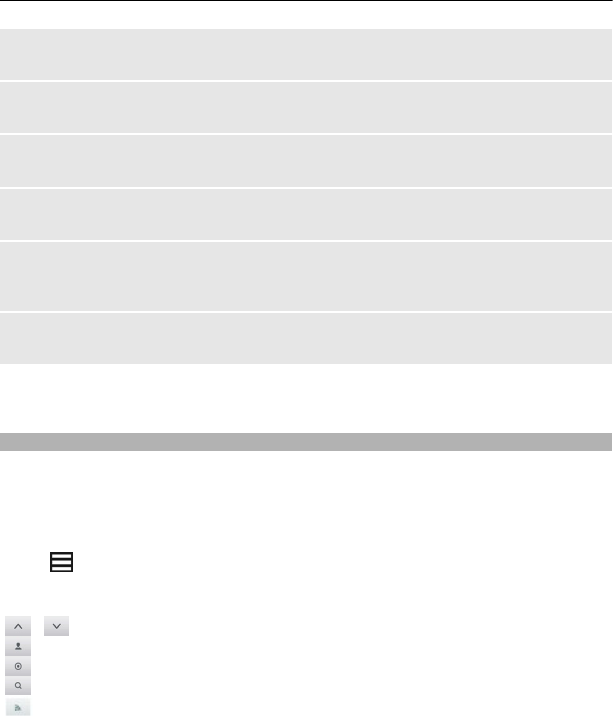
Go to a website
Select the address bar, and enter the address.
Move on the web page
Drag the page with your finger.
Zoom in
Select the desired section of the web page.
Zoom out
Double-tap the screen.
Search the internet
Select the search field, and enter a search word. If prompted, select your default search
engine.
Return to a previously visited web page
Open the History tab, and select the web page.
Tip: You can download web apps from Nokia Store. When you first open a web app, it
is added as a bookmark. For more information, go to www.nokia.com.
Fit a web page to your phone display
Your web browser can optimise web pages for your phone display. Instead of having to
zoom in, the web page is arranged into a single column of larger, readable text and
pictures.
Select Menu > Internet.
Select > Tools > Column view.
To quickly go to different sections of a web page, select from the following:
/ Go to the previous or next section of the web page.
Sign in to the web page.
Go to the main section of the web page.
Search the web page.
Read RSS feeds.
The available options may vary.
This view is not available for web sites designed for mobile use.
32
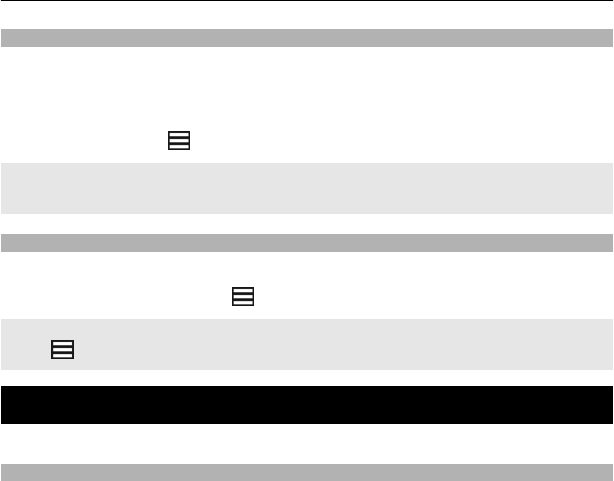
Add a bookmark
If you visit the same websites all the time, add them as bookmarks, so you can easily
access them.
Select Menu > Internet.
While browsing, select > Add to favourites.
Go to a bookmarked website
Open the Favourites tab, and select a bookmark.
Clear your browsing history
Select Menu > Internet.
Open the History tab, and select > Clear history.
Clear stored cookies or text saved in web forms
Select > Tools > Settings > Clear cookies or Clear auto-fill.
Keep in touch with your online friends
Learn how to make the most of your favourite social networking services.
About Communities
Select Menu > Apps > Apps and games > Communities, and sign in to your relevant
social networking services.
With the Communities application, you can enhance your social networking experience.
The application may not be available in all regions. When signed in to social networking
services, such as Facebook or Twitter, you can do the following:
•See your friends' status updates
•Post your own status update
•Instantly share pictures you take with the camera
Only those features that are supported by the social networking service are available.
Using social networking services requires network support. This may involve the
transmission of large amounts of data and related data traffic costs. For information
about data transmission charges, contact your service provider.
The social networking services are third party services and not provided by Nokia. Check
the privacy settings of the social networking service you are using as you may share
33
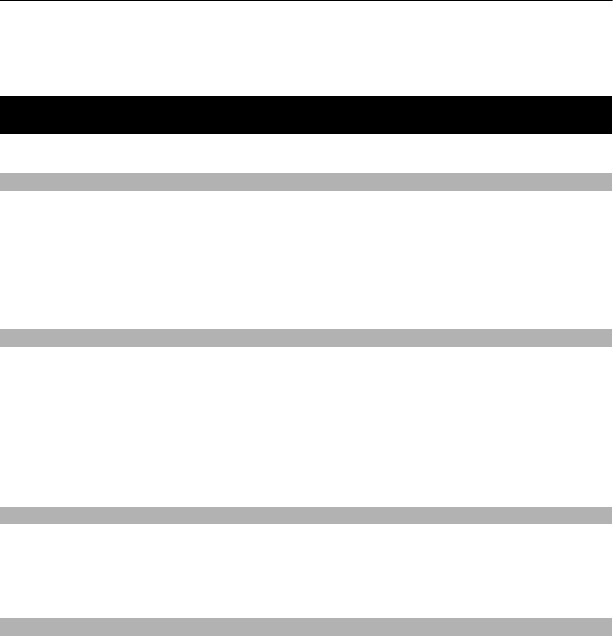
information with a large group of people. The terms of use of the social networking
service apply to sharing information on that service. Familiarise yourself with the terms
of use and the privacy practices of that service.
Mail and chat
Learn how to send and receive mail, and how to chat with your friends.
About Mail
Select Menu > Mail.
You can use your phone to read and send mail from your mail accounts from different
mail service providers.
If you do not already have a mail account, you can create a Nokia Mail account. For more
information, go to www.nokia.com/support.
Send a mail
Select Menu > Mail and a mail account.
1 Select Options > Compose new.
2 Enter the recipient’s mail address and the subject, and write your message.
3 To attach a file, for example, a picture, select Options > Attach > From Gallery.
4 To take a picture to attach to the mail, select Options > Attach > From Camera.
5 Select Send.
Read and reply to mail
Select Menu > Mail and a mail account.
1 Select a mail.
2 To reply to or forward a mail, select Options.
About Chat
Select Menu > Chat.
You can exchange instant messages with your friends. Chat is a network service. If you
do not have a chat account, you can create a Nokia account, and use Nokia's Ovi Chat.
You can leave the Chat application running in the background while you use other
features of your phone, and still be notified of new instant messages.
Using services or downloading content may cause transfer of large amounts of data,
which may result in data traffic costs.
34

Chat with your friends
Select Menu > Chat.
You can sign in to and chat in several services at the same time. You must separately
sign in to each service.
You can have ongoing conversations with several contacts at the same time.
1 If several chat services are available, select the desired service.
2 Sign in to the service.
3 In your contacts list, select the contact you want to chat with.
4 Write your message in the text box at the bottom of the display.
5 Select Send.
Nokia Maps
Learn how to find your way around with the maps available on your phone.
About Maps
Select Menu > Maps.
Maps shows you what is nearby and helps you plan your route, free of charge. You can:
•View your current location
•Plan a route to a nearby place
•Search for a place or specific address, and save it
•Send your location or a place to a friend in a text message
Your phone may have a memory card with preloaded maps for your country. Insert the
memory card into the phone before using Maps.
Using services or downloading content may cause transfer of large amounts of data,
which may result in data traffic costs.
Contents of digital maps may sometimes be inaccurate and incomplete. Never rely solely
on the content or the service for essential communications, such as in emergencies.
Download maps
Save new street maps to your phone before a journey, so you can browse the maps
without an internet connection when travelling.
Use the Nokia Ovi Suite PC application to download maps. Make sure you have the latest
version of Nokia Ovi Suite installed on your computer.
35

To download and install Nokia Ovi Suite on your compatible computer, go to
www.nokia.com/software.
Download maps using your phone
If you browse to an area which is not covered by the maps already downloaded on the
memory card, and you have an active data connection, a map for the area is
automatically downloaded through the internet.
Using services or downloading content may cause transfer of large amounts of data,
which may result in data traffic costs.
View your current location on the map
Select Menu > Maps and My position.
Update your current location
Select Options > Update position.
Save your current location
Select Options > Save as favourite.
Tip: After finding your location, you can search for nearby places. Select Options >
Search nearby.
An internet connection may be required to find your current location.
Using services or downloading content may cause transfer of large amounts of data,
which may result in data traffic costs.
Find a place
Maps helps you find specific locations and addresses.
Select Menu > Maps.
1 Select Search.
2 Enter the name of the place or address.
3 Select Go. A list of matching places or addresses is displayed.
Refine your search
1 Select Advanced > Find place or Find address.
2 Define more details for your search, and follow the instructions.
Tip: To search from the entire category of places, leave all name fields blank.
36

Tip: If you can't find the place you are looking for, try to search from an online database.
Select Search online for. Additional charges may apply. For details, contact your service
provider.
Share your location or a place
When you want to show your friends where a place is on the map, you can send the
place to them in a text message.
Select Menu > Maps.
To view the place on the map, your friends don't need to have a Nokia phone, but an
internet connection is required.
1 Select My position or a place on the map and Options > Send this place.
2 Write your message. The address and a link to the location are automatically added.
Create a walking route
Create a walking route to a nearby place. You can view the route and all the turnings
on the map before setting off.
Select Menu > Maps.
1 Select Plan route.
2 Select Starting location and a saved or recent location, a place from the map, or a
specific address as the start point of your walking route. To start from your current
position, select My position.
3 Select Destination and the end point of the walking route.
The maximum distance between the start and end points is 10 kilometres,
measured in a straight line. Using ferries and some special tunnels for walking
routes is restricted.
4 Select Go > Start.
5 To cancel the route, select Options > Cancel route.
Nokia Services
Learn about Nokia Services, and how to use them with your phone.
Availability and costs of Nokia Services
The availability of Nokia Services may vary by region.
Using services or downloading content may cause transfer of large amounts of data,
which may result in data traffic costs.
To learn more, go to www.nokia.com/support.
37
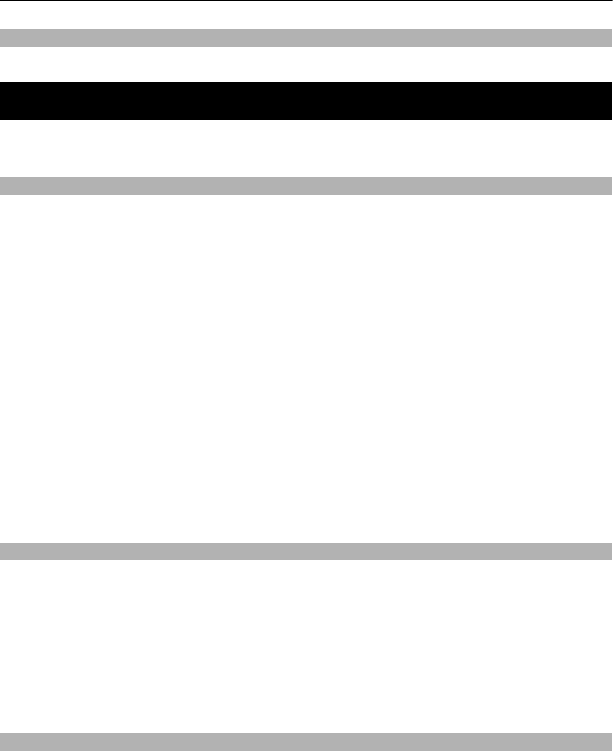
Access Nokia Services
Select Menu > Apps > Apps and games and the desired service.
Find help
Learn how to find more information about your phone, and how to update the phone
software.
Support
When you want to learn more about how to use your product or you are unsure how
your phone should function, read the user guide thoroughly.
You may also be interested in the Nokia Support Video channel in YouTube.
If this does not resolve your issue, do one of the following:
•Reboot your phone. Switch off the phone, and remove the battery. After about a
minute, replace the battery, and switch on the phone.
•Update your phone software
•Restore the original factory settings
If your issue remains unsolved, contact Nokia for repair options. Go to www.nokia.com/
repair, or in Latin America, www.nokia-latinoamerica.com/centrosdeservicio. Before
sending your phone for repair, always back up your data, as all personal data in your
phone may be deleted.
For additional product support information, see the warranty and reference leaflet
included with your Nokia device.
Subscribe to the Tips and Offers service
Tips and Offers is a convenient service to help you get the most out of your phone,
providing you with tips and support messages, as well as updates for your games and
applications.
Select Menu > Apps > Apps and games > Tips and offers.
Text message charges may apply when you subscribe or unsubscribe. For terms and
conditions, see the documentation supplied with your phone, or go to www.nokia.com/
mynokia.
Keep your phone up to date
Learn how to update your phone software and individual applications.
38

Update phone software using your phone
Want to improve the performance of your phone and get application updates and great
new features? Update the software regularly to get the most out of your phone. You
can also set your phone to automatically check for updates.
Warning:
If you install a software update, you cannot use the device, even to make emergency
calls, until the installation is completed and the device is restarted.
Using services or downloading content may cause transfer of large amounts of data,
which may result in data traffic costs.
Before starting the update, connect a charger or make sure the device battery has
enough power.
Select Menu > Settings.
1 Select Device > Device updates.
2 To display the current software version and check whether an update is available,
select Current sw details.
3 To download and install a software update, select Downl. device sw. Follow the
displayed instructions.
4 If the installation was cancelled after the download, select Install sw update.
The software update may take several minutes. If there are problems with the
installation, contact your network service provider.
Check for software updates automatically
Select Automatic SW update, and define how often to check for new software updates.
39

Your network service provider may send phone software updates over the air directly
to your phone. For more information on this network service, contact your network
service provider.
Update phone software using your PC
You can use the Nokia Suite PC application to update your phone software. You need a
compatible PC, a high-speed internet connection, and a compatible USB data cable to
connect your phone to the PC.
To get more information and to download the Nokia Suite application, go to
www.nokia.com/software.
Restore original settings
If your phone is not working properly, you can reset some settings to their original
values.
1 End all calls and connections.
2 Select Menu > Settings and Rest. fact. sett. > Settings only.
3 Enter the security code.
This does not affect documents or files stored on your phone.
After restoring the original settings, your phone switches off and then on again. This
may take longer than usual.
Organise files
You can move, copy, and delete files and folders, or create new folders in your phone
memory or on the memory card. If you organise your files into their own folders, it might
help you find the files in future.
Select Menu > Apps > Gallery.
Create a new folder
In the folder where you want to create a sub-folder, select Options > Add folder.
Copy or move a file to a folder
Select and hold the file, and from the pop-up menu, select the appropriate option.
Tip: You can also play music or videos, or view pictures in Gallery.
Back up your pictures and other content to a memory card
Want to make sure you will not lose any important files? You can back up your phone
memory to a compatible memory card.
40

Select Menu > Settings > Sync & backup.
Select Create backup.
Restore a backup
Select Restore backup.
Protect the environment
Save energy
You do not need to charge your battery so often if you do the following:
•Close applications and data connections, such as your Wi-Fi or Bluetooth connection,
when not in use.
•Set your phone to enter power saver mode after the minimum period of inactivity.
•
Recycle
When this phone has reached the end of its working life, all of its materials can be
recovered as materials and energy. To guarantee the correct disposal and reuse, Nokia
co-operates with its partners through a program called We:recycle. For information on
how to recycle your old Nokia products and where to find collection sites, go to
www.nokia.com/werecycle, or call the Nokia Care contact centre.
Recycle packaging and user guides at your local recycling scheme.
For more information on the environmental attributes of your phone, go to
www.nokia.com/ecoprofile.
Product and safety information
Network services and costs
Your device is approved for use on the WCDMA 850/900/1700/1900/2100 (Pentaband, HSPA) and EGSM850/900/1800/1900
(Quadband).
To use the device, you need a subscription with a service provider.
Using network services and downloading content to your device requires a network connection and may result in data traffic
costs. Some product features require support from the network, and you may need to subscribe to them.
41

Take care of your device
Handle your device, battery, charger and accessories with care. The following suggestions help you protect your warranty
coverage.
•Keep the device dry. Precipitation, humidity, and all types of liquids or moisture can contain minerals that corrode
electronic circuits. If your device gets wet, remove the battery, and allow the device to dry.
•Do not use or store the device in dusty or dirty areas. Moving parts and electronic components can be damaged.
•Do not store the device in high temperatures. High temperatures can shorten the life of the device, damage the battery,
and warp or melt plastics.
•Do not store the device in cold temperatures. When the device warms to its normal temperature, moisture can form inside
the device and damage electronic circuits.
•Do not attempt to open the device other than as instructed in the user guide.
•Unauthorised modifications may damage the device and violate regulations governing radio devices.
•Do not drop, knock, or shake the device. Rough handling can break internal circuit boards and mechanics.
•Only use a soft, clean, dry cloth to clean the surface of the device.
•Do not paint the device. Paint can clog moving parts and prevent proper operation.
•Switch off the device and remove the battery from time to time for optimum performance.
•Keep your device away from magnets or magnetic fields.
•To keep your important data safe, store it in at least two separate places, such as your device, memory card, or computer,
or write down important information.
During extended operation, the device may feel warm. In most cases, this is normal. If you suspect the device is not working
properly, take it to the nearest authorised service facility.
Recycle
Always return your used electronic products, batteries, and packaging materials to dedicated collection points. This way you
help prevent uncontrolled waste disposal and promote the recycling of materials. Check how to recycle your Nokia products at
www.nokia.com/recycling..
About Digital Rights Management
When using this device, obey all laws and respect local customs, privacy and legitimate rights of others, including copyrights.
Copyright protection may prevent you from copying, modifying, or transferring pictures, music, and other content.
Content owners may use different types of digital rights management (DRM) technologies to protect their intellectual property,
including copyrights. This device uses various types of DRM software to access DRM-protected content. With this device you can
access content protected with WMDRM 10 and OMA DRM 2.0. If certain DRM software fails to protect the content, content owners
may ask that such DRM software's ability to access new DRM-protected content be revoked. Revocation may also prevent renewal
of such DRM-protected content already in your device. Revocation of such DRM software does not affect the use of content
protected with other types of DRM or the use of non-DRM-protected content.
Digital rights management (DRM) protected content comes with an associated licence that defines your rights to use the content.
If your device has OMA DRM-protected content, to back up both the licences and the content, use the backup feature of Nokia
Ovi Suite.
Other transfer methods may not transfer the licences which need to be restored with the content for you to be able to continue
the use of OMA DRM-protected content after the device memory is formatted. You may also need to restore the licences if the
files on your device become corrupted.
If your device has WMDRM-protected content, both the licences and the content are lost if the device memory is formatted. You
may also lose the licences and the content if the files on your device become corrupted. Losing the licences or the content may
limit your ability to use the same content on your device again. For more information, contact your service provider.
42

Batteries and chargers
Battery and charger information
Your device is intended for use with a BP-3L rechargeable battery. Nokia may make additional battery models available for this
device. Always use original Nokia batteries.
This device is intended for use when supplied with power from the following chargers: AC-11. The exact Nokia charger model
number may vary depending on the plug type, identified by E, X, AR, U, A, C, K, or B.
The battery can be charged and discharged hundreds of times, but it will eventually wear out. When the talk and standby times
are noticeably shorter than normal, replace the battery.
Battery safety
Always switch the device off and disconnect the charger before removing the battery. When you unplug a charger or an
accessory, hold and pull the plug, not the cord.
When your charger is not in use, unplug it from the electrical plug and the device. Do not leave a fully charged battery connected
to a charger, as overcharging may shorten the battery’s lifetime. If left unused, a fully charged battery will lose its charge over
time.
Always keep the battery between 15°C and 25°C (59°F and 77°F). Extreme temperatures reduce the capacity and lifetime of the
battery. A device with a hot or cold battery may not work temporarily.
Accidental short-circuiting can happen when a metallic object touches the metal strips on the battery, for example, if you carry
a spare battery in your pocket. Short-circuiting may damage the battery or the connecting object.
Do not dispose of batteries in a fire as they may explode. Dispose of batteries according to local regulations. Recycle when
possible. Do not dispose as household waste.
Do not dismantle, cut, open, crush, bend, puncture, or shred cells or batteries. If a battery leaks, do not let battery liquid touch
skin or eyes. If this happens, immediately flush the affected areas with water, or seek medical help.
Do not modify, remanufacture, attempt to insert foreign objects into the battery, or immerse or expose it to water or other
liquids. Batteries may explode if damaged.
Use the battery and charger for their intended purposes only. Improper use, or use of unapproved batteries or incompatible
chargers may present a risk of fire, explosion, or other hazard, and may invalidate any approval or warranty. If you believe the
battery or charger is damaged, take it to a service centre for inspection before continuing to use it. Never use a damaged battery
or charger. Only use the charger indoors.
Additional safety information
Make an emergency call
1 Make sure the device is switched on.
2 Check for adequate signal strength. You may also need to do the following:
•Insert a SIM card.
•Deactivate call restrictions you have activated for your device, such as call barring, fixed dialling, or closed user
group.
•Make sure the flight profile is not activated.
•If the device screen and keys are locked, unlock them.
3 Press the end key repeatedly, until the home screen is displayed.
4 Enter the official emergency number for your present location. Emergency call numbers vary by location.
5Press the call key.
6 Give the necessary information as accurately as possible. Do not end the call until given permission to do so.
43

Important: Activate both cellular and internet calls, if your device supports internet calls. The device may attempt to make
emergency calls both through cellular networks and through your internet call service provider. Connections in all conditions
cannot be guaranteed. Never rely solely on any wireless device for essential communications like medical emergencies.
Small children
Your device and its accessories are not toys. They may contain small parts. Keep them out of the reach of small children.
Medical devices
Operation of radio transmitting equipment, including wireless phones, may interfere with the function of inadequately
protected medical devices. Consult a physician or the manufacturer of the medical device to determine whether they are
adequately shielded from external radio frequency energy.
Implanted medical devices
Manufacturers of medical devices recommend a minimum separation of 15.3 centimetres (6 inches) between a wireless device
and an implanted medical device, such as a pacemaker or implanted cardioverter defibrillator, to avoid potential interference
with the medical device. Persons who have such devices should:
•Always keep the wireless device more than 15.3 centimetres (6 inches) from the medical device.
•Not carry the wireless device in a breast pocket.
•Hold the wireless device to the ear opposite the medical device.
•Turn the wireless device off if there is any reason to suspect that interference is taking place.
•Follow the manufacturer directions for the implanted medical device.
If you have any questions about using your wireless device with an implanted medical device, consult your health care provider.
Accessibility solutions
Nokia is committed to making mobile phones easy to use for all individuals, including those with disabilities. For more
information, visit the Nokia website at www.nokiaaccessibility.com.
Hearing
Warning:
When you use the headset, your ability to hear outside sounds may be affected. Do not use the headset where it can endanger
your safety.
Some wireless devices may interfere with some hearing aids.
Nickel
The surface of this device is nickel-free.
Protect your device from harmful content
Your device may be exposed to viruses and other harmful content. Take the following precautions:
•Be cautious when opening messages. They may contain malicious software or otherwise be harmful to your device or
computer.
•Be cautious when accepting connectivity requests, browsing the internet, or downloading content. Do not accept
Bluetooth connections from sources you do not trust.
•Only install and use services and software from sources that you trust and that offer adequate security and protection.
•Install antivirus and other security software on your device and any connected computer. Only use one antivirus
application at a time. Using more may affect performance and operation of the device and/or computer.
44

•If you access preinstalled bookmarks and links to third party internet sites, take the appropriate precautions. Nokia does
not endorse or assume liability for such sites.
Operating environment
This device meets radio frequency exposure guidelines in the normal use position at the ear or at least 1.5 centimetres (5/8 inch)
away from the body. Any carry case, belt clip, or holder for body-worn operation should not contain metal and should position
the device the above-stated distance from your body.
To send data files or messages requires a quality connection to the network. Data files or messages may be delayed until such
a connection is available. Follow the separation distance instructions until the transmission is completed.
Vehicles
Radio signals may affect improperly installed or inadequately shielded electronic systems in motor vehicles such as electronic
fuel injection, electronic antilock braking, electronic speed control, and air bag systems. For more information, check with the
manufacturer of your vehicle or its equipment.
Only qualified personnel should install the device in a vehicle. Faulty installation or service may be dangerous and may invalidate
your warranty. Check regularly that all wireless device equipment in your vehicle is mounted and operating properly. Do not
store or carry flammable liquids, gases, or explosive materials in the same compartment as the device, its parts, or accessories.
Remember that air bags inflate with great force. Do not place your device or accessories in the air bag deployment area.
Potentially explosive environments
Switch off your device in any area with a potentially explosive atmosphere, for example near gas pumps at service stations.
Sparks in such areas could cause an explosion or fire resulting in bodily injury or death. Observe restrictions in fuel service
stations, storage, and distribution areas; chemical plants; or where blasting operations are in progress. Areas with a potentially
explosive atmosphere are often, but not always, clearly marked. They include areas where you would be advised to turn off
your vehicle engine, below deck on boats, chemical transfer or storage facilities and where the air contains chemicals or particles
such as grain, dust, or metal powders. You should check with the manufacturers of vehicles using liquefied petroleum gas (such
as propane or butane) to determine if this device can be safely used in their vicinity.
Certification information (SAR)
This mobile device meets guidelines for exposure to radio waves.
Your mobile device is a radio transmitter and receiver. It is designed not to exceed the limits for exposure to radio waves
recommended by international guidelines. These guidelines were developed by the independent scientific organisation ICNIRP
and include safety margins designed to assure the protection of all persons, regardless of age and health.
The exposure guidelines for mobile devices employ a unit of measurement known as the Specific Absorption Rate or SAR. The
SAR limit stated in the ICNIRP guidelines is 2.0 watts/kilogram (W/kg) averaged over 10 grams of tissue. Tests for SAR are
conducted using standard operating positions with the device transmitting at its highest certified power level in all tested
frequency bands. The actual SAR level of an operating device can be below the maximum value because the device is designed
to use only the power required to reach the network. That amount changes depending on a number of factors such as how
close you are to a network base station.
The highest SAR value under the ICNIRP guidelines for use of the device at the ear is 0.79 W/kg.
Use of device accessories may result in different SAR values. SAR values may vary depending on national reporting and testing
requirements and the network band. Additional SAR information may be provided under product information at
www.nokia.com.
Your mobile device is also designed to meet the requirements for exposure to radio waves established by the Federal
Communications Commission (USA) and Industry Canada. These requirements set a SAR limit of 1.6 W/kg averaged over one
gram of tissue. The highest SAR value reported under this standard during product certification for use at the ear is 1.16 W/kg
and when properly worn on the body is 1.10 W/kg.
45
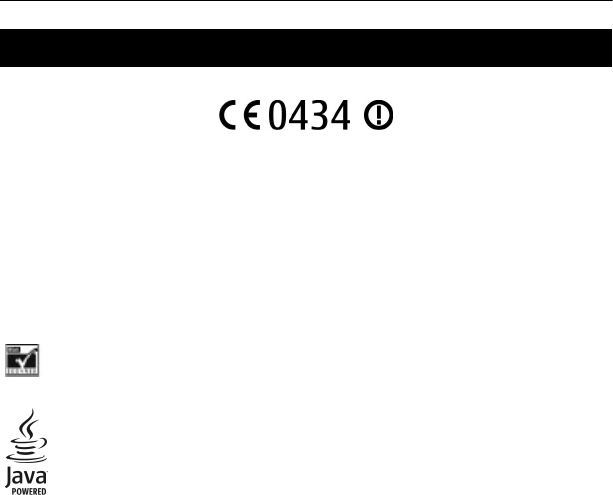
Copyright and other notices
DECLARATION OF CONFORMITY
Hereby, NOKIA CORPORATION declares that this RM-763 product is in compliance with the essential requirements and other
relevant provisions of Directive 1999/5/EC. A copy of the Declaration of Conformity can be found at http://www.nokia.com/
phones/declaration_of_conformity/.
© 2011 Nokia. All rights reserved.
Nokia, Nokia Connecting People, Ovi, and WE: logo are trademarks or registered trademarks of Nokia Corporation. Nokia tune
is a sound mark of Nokia Corporation. Other product and company names mentioned herein may be trademarks or tradenames
of their respective owners.
Reproduction, transfer, distribution, or storage of part or all of the contents in this document in any form without the prior
written permission of Nokia is prohibited. Nokia operates a policy of continuous development. Nokia reserves the right to make
changes and improvements to any of the products described in this document without prior notice.
Includes RSA BSAFE cryptographic or security protocol software from RSA Security.
Oracle and Java are registered trademarks of Oracle and/or its affiliates.
Portions of the Nokia Maps software are ©1996-2011 The FreeType Project. All rights reserved.
The Bluetooth word mark and logos are owned by the Bluetooth SIG, Inc. and any use of such marks by Nokia is under license.
To the maximum extent permitted by applicable law, under no circumstances shall Nokia or any of its licensors be responsible
for any loss of data or income or any special, incidental, consequential or indirect damages howsoever caused.
The contents of this document are provided "as is". Except as required by applicable law, no warranties of any kind, either
express or implied, including, but not limited to, the implied warranties of merchantability and fitness for a particular purpose,
are made in relation to the accuracy, reliability or contents of this document. Nokia reserves the right to revise this document
or withdraw it at any time without prior notice.
The availability of products, features, applications and services may vary by region. For more information, contact your Nokia
dealer or your service provider. This device may contain commodities, technology or software subject to export laws and
regulations from the US and other countries. Diversion contrary to law is prohibited.
Nokia does not provide a warranty for or take any responsibility for the functionality, content, or end-user support of third-
party applications provided with your device. By using an application, you acknowledge that the application is provided as is.
Nokia does not make any representations, provide a warranty, or take any responsibility for the functionality, content, or end-
user support of third-party applications provided with your device.
The availability of Nokia services may vary by region.
46

FCC/INDUSTRY CANADA NOTICE
Your device may cause TV or radio interference (for example, when using a telephone in close proximity to receiving equipment).
The FCC or Industry Canada can require you to stop using your telephone if such interference cannot be eliminated. If you require
assistance, contact your local service facility. This device complies with part 15 of the FCC rules and Industry Canada licence-
exempt RSS standard(s). Operation is subject to the following two conditions: (1) This device may not cause harmful interference,
and (2) this device must accept any interference received, including interference that may cause undesired operation. Any
changes or modifications not expressly approved by Nokia could void the user's authority to operate this equipment.
Some operations and features are SIM card and/or network dependent, MMS dependent, or dependent on the compatibility of
devices and the content formats supported. Some services are subject to a separate charge.
/Issue 1 EN
47
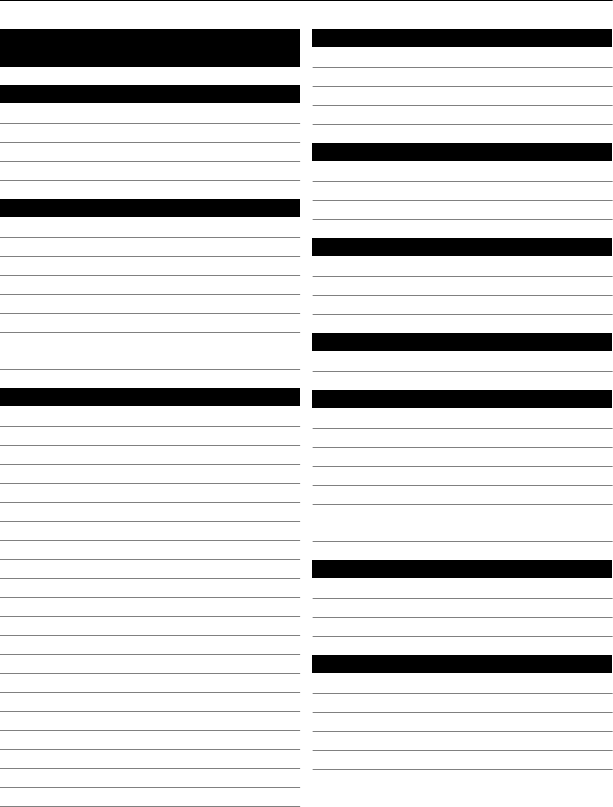
Index
A
access codes 11
alarm clock 23
alarms 23
antennas 11
B
backing up data 40
battery 6, 43
— charging 9
Bluetooth 24
bookmarks 33
browser
See web browser
business cards 24
C
cable connection 25
Calendar 23
calls
— emergency 43
— internet calls 16
— log 15
— making 15
camera
— recording videos 30
— sending pictures and videos 30
— taking pictures 30
charging the battery 43
chat services (IM) 34, 35
clock 23
connectivity 26
contacts
— adding 17
— copying 14
— saving 17
conversations 20
copying content 14, 25
D
data connections
— Bluetooth 24
— WLAN 26
date and time 23
E
e-mail 34
emergency calls 43
environmental tips 41
F
factory settings, restoring 40
file management 40
FM radio 28
H
home screen 21
I
IM (instant messaging) 34, 35
IMEI number 11
inbox, messages 20
indicators 14
internet
See web browser
internet calls 16
K
keyboard 5, 18
keyguard 12
keys and parts 5
L
lock code 11
locking
— keys 12
— screen 12
loudspeaker 15
48
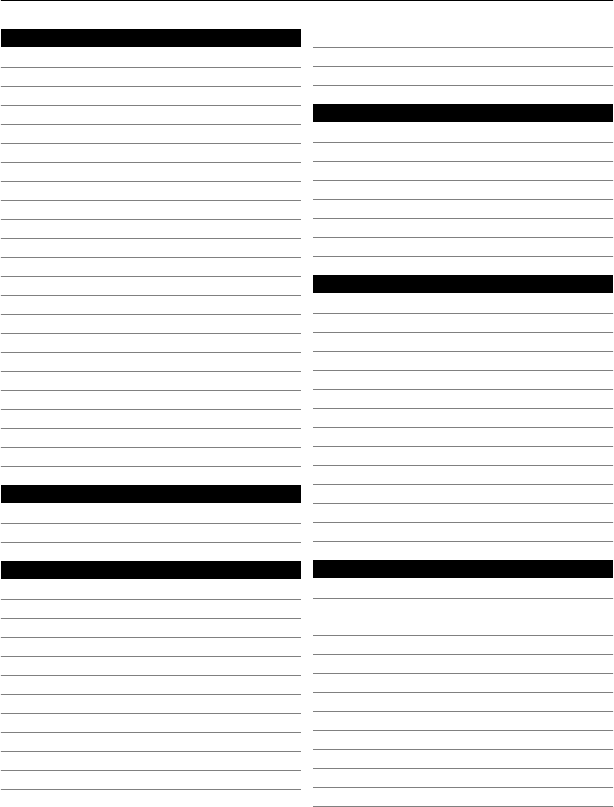
M
mail 34
— creating 34
— reading and replying to 34
— sending 34
mailbox
— voice 20
Maps 35
— creating routes 37
— current location 36
— downloading maps 35
— searching 36
— sharing 37
media key 30
meeting entries 23
memory card 8
messages 20
— audio 21
— sending 19
messaging key 20
MMS (multimedia message service) 19
multimedia messages 19
music 29
N
Nokia Services 37, 38
Nokia support information 38
P
personalising your phone 21, 22
phone
— switching on/off 10
Phone switch 14
pictures
— copying 14, 25
— sending 24, 30
— taking 30
PIN codes 11
powering on/off 10
predictive text input 19
profiles
— personalising 22
PUK codes 11
R
radio 28
recording
— videos 30
recycling 41
restoring data 40
restoring settings 40
ringtones 22
S
searching
— radio stations 28
security code 11
settings
— restoring 40
SIM card 6
SMS (short message service) 19
social networks 33
software updates 39, 40
speed dialling 17
strap 10
support 38
switching on/off 10
T
taking pictures
See camera
text input 5, 18, 19
text messages 19
themes 21
time and date 23
Tips and Offers 38
tones
— personalising 22
touch screen 12
transferring content 14, 25
turning on/off 10
49
